You need time to travel to Koh Sdach, a small island in the Gulf of Thailand in Cambodia’s Koh Kong Province. An appetite for adventure also helps, as simply getting to the island is a bit more challenging than reaching better-known destinations such as Siem Reap or Kampot. But if you are after something a little different, crave immersion into local life, and fancy some fantastic snorkeling and scuba diving, then the trip is worth both the time and the energy.
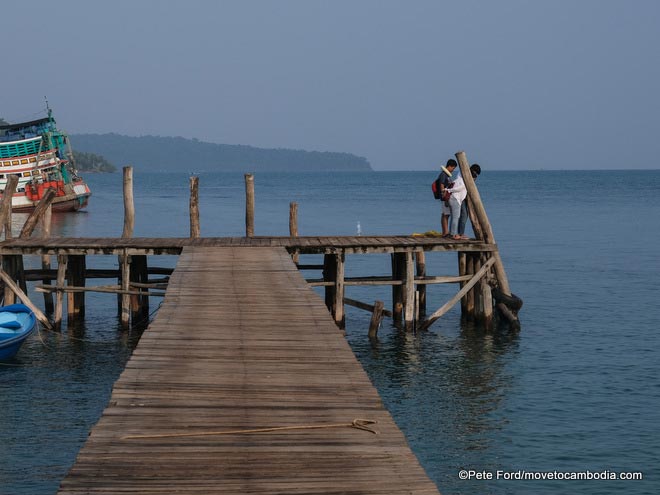
Koh Sdach is only a short boat ride from the mainland.
First, catch a mini-van or shared taxi from Koh Kong, Sihanoukville, or Phnom Penh to Kiri Sakor commune, which consists of a small collection of shacks at the end of a rutted track. The drive takes about six hours from Phnom Penh, but the roads are fairly smooth throughout. When you arrive, you can jump in a boat that can take you out to Koh Sdach, visible across the narrow strait. A seat on a small speedboat is a modest 5,000 riel ($1.25) for a cruise that takes all of five minutes to reach the island, home to some 3,000 residents who are mostly engaged in fishing. At the harbor, boats of all sizes and waterfront homes on stilts line the docks, while mountains of polystyrene boxes keep the catches destined for Phnom Penh and Vietnam on ice.
You’ll notice right away just how far off the main foreign-tourist trail the island is. The small market, barbers, salons, and shops that line much of Koh Sdach’s main strip, all of two motorbikes wide, are clearly aimed at local families and fishers on shore leave. This is precisely what makes Koh Sdach such an appealing destination, especially for Phnom Penh residents looking to enjoy the coast without the noise and frenzy of tourist crowds.
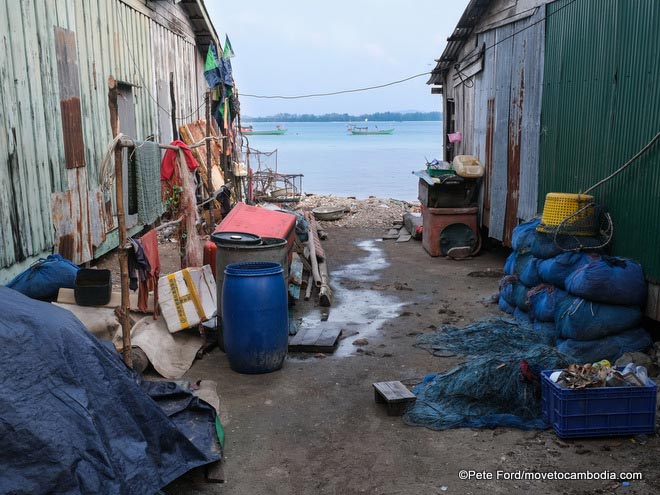
Never far from the sea on Koh Sdach
Koh Sdach has no great beaches and certainly no full-moon forest raves. Indeed, there are none of the foreigner-friendly attractions that draw tourists to the more famous Koh Rong islands off the Sihanoukville coast. But Koh Sdach’s two diving centers, Kuda Divers and Octopus Cambodia, offer a low-key base from which to snorkel or scuba, learn more about environmental protection efforts, and experience the day-to-day life of Cambodia’s coast.
Roger, the owner of Kuda Divers, explains that the island’s relatively low tourist numbers have helped minimize the physical damage that coral reefs elsewhere in Cambodia have suffered. Efforts by NGOs, members of the local community, and Cambodian authorities to stop illegal fishing practices such as dynamiting and electrified nets are also underway. This just might help give fish and other undersea life a chance of surviving despite the ever-growing demands from fishing communities along the Cambodian coast that are facing lower catches, rising pollution, and increased competition.
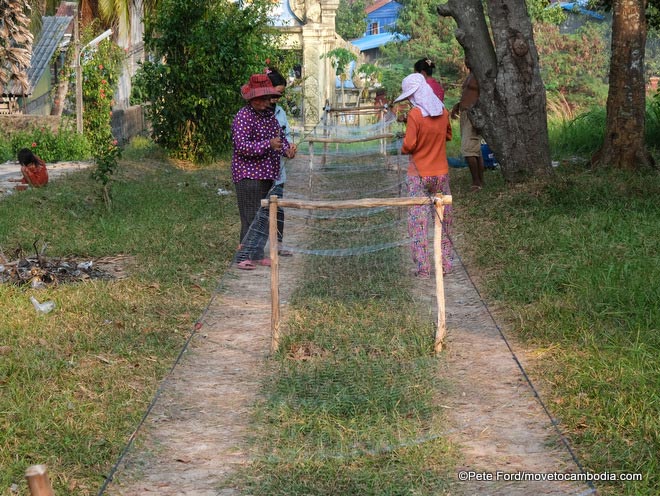
Villagers mending fishing nets in the pagoda grounds on Koh Sdach.
Unfortunately, the threats to the environmental health of Cambodia’s coast are painfully apparent to anyone wishing to look. The plastic litter that chokes the shoreline of Koh Sdach village is an ugly reminder of the challenges posed by plastic waste to communities ill equipped to deal with it. While metal is easily recycled, plastic is instead burned (if it is collected at all), polluting the air. Moreover, the plastic bags and bottles bobbing on the surface are only a tiny indication of the problem; the team at Kuda Divers says they have collected more than 2.5 tons of plastic and netting waste from the reefs during dives.
The trip to Koh Sdach offers additional evidence of the environmental challenges facing Cambodia. The newly constructed road for the massive Dara Sakor development, which sits halfway between Koh Kong City and Sihanoukville and overlooks Koh Sdach, offers a stark reminder of how quickly this once remote part of Cambodia is changing. The former dense forest has been cleared from the road, leaving behind charred stumps as memorials for what has been lost, while poor families move in to claim land for cassava cultivation.
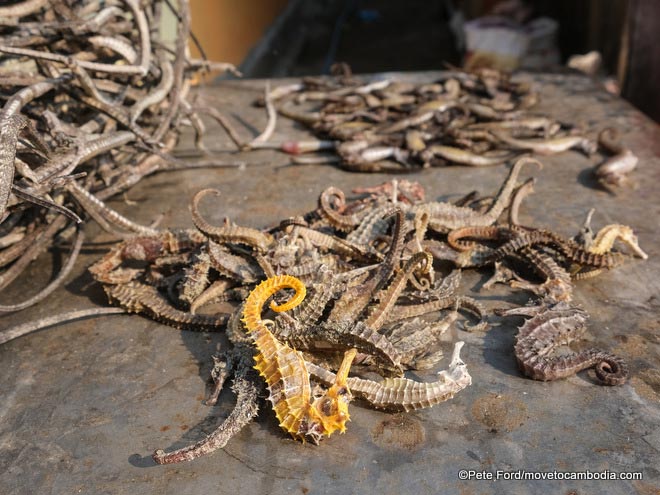
Illegal marine exploitation on display in the market on Koh Sdach.
Notwithstanding the environmental threats looming over the island’s reefs, Koh Sdach is still a fantastic place to see underwater life, including sea horses, coral reefs, and sea grass, and to experience what does remain of the vital oceanic ecosystem that is now under global threat. It also offers an opportunity to witness examples of the efforts communities and NGOs are making to preserve local natural beauty.
And for now this bit of the Cambodian coast is still beautiful and vibrant. The visible challenges and pressures the coastline faces, and the lengths that local residents go to provide a livelihood for their families, are snapshots of the reality of life in rural Cambodia, a world away from the 24-hour supermarkets and Mexican restaurants of Phnom Penh or Siem Reap. For visitors to the Kingdom of Wonder, a trip out to Koh Sdach gives an authentic glimpse of Cambodia that is hard to beat. And for Phnom Penh’s army of expats, Koh Sdach is an intimate reminder of a different side of Cambodia.
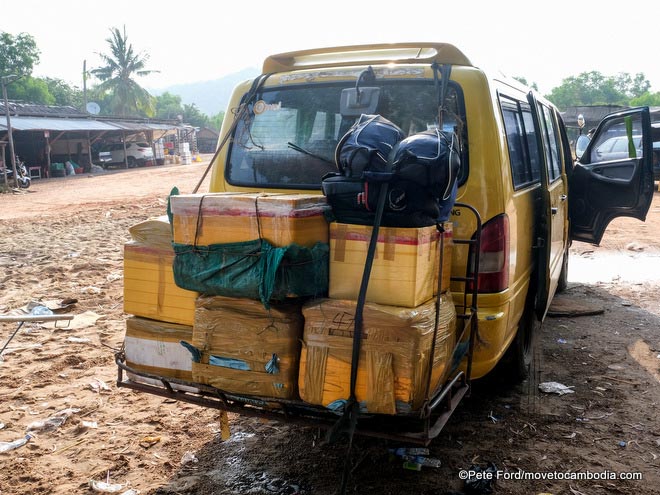
A minivan, fully loaded with seafood from Koh Sdach, waits for passengers for the return to Phnom Penh
Practicalities
Only one or two minivans drive directly each morning from Phnom Penh’s Mondial Center bus depot to Koh Sdach, $6 one way. Arriving for the 7 a.m. start is key to getting your seat of choice, before the six-hour drive to the coast.
There are a number of guesthouses on the island, starting at $15 for air-conditioned rooms. I recommend both Kuda Divers and Octopus Cambodia; they offer affordable semi- and full-board options and a range of diving and snorkeling activities as well.
For those seeking even more silence and seclusion, Nomads Cambodia on nearby Koh Totang island has a pristine beach, solar-powered bungalows, and easy access to a coral reef (you can see it from the island’s dock).
Work in the Philippines by Canadian biologist Amanda Vincent and the Seahorse Project seems to be leading toward conservation and a true sustainable take of seahorses there. I wonder if there’d be a chance of the people of Koh Sdach or Koh Totang could take this path? http://www.projectseahorse.org
Hi Josė
Kudadivers is already one of project seahorse biggest contributors of seahorse data and is looking forward to further cooperation with them. Check out all the sightings on iseahorse.org :)